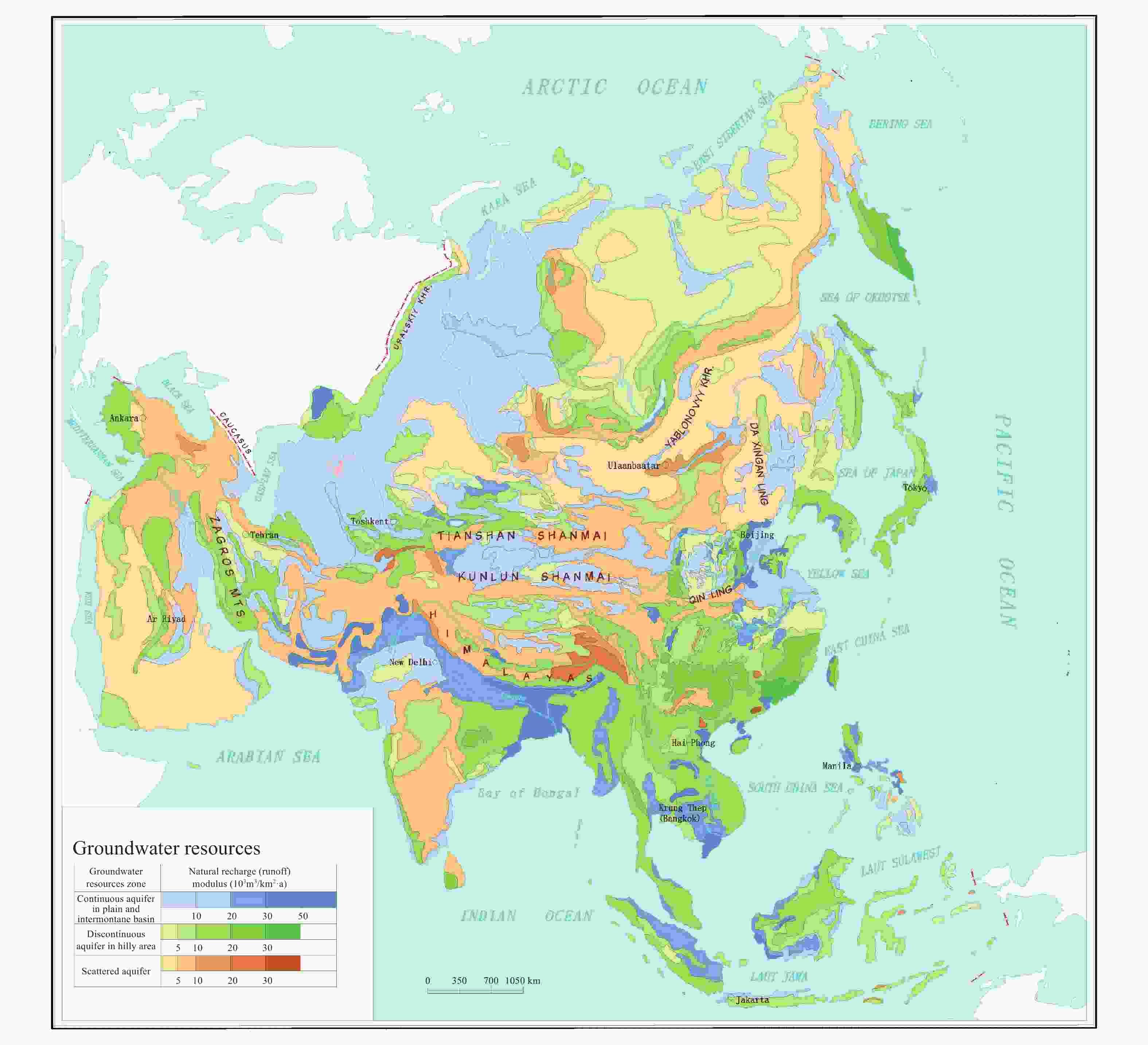-
Abstract: The natural groundwater recharge in Asia is estimated to be 4 677.74×109 m3/a. However, it features extremely uneven spatial-temporal distribution. Groundwater is distributed in various natural and geological environments, and it is liable to be affected by numerous factors and possesses different properties. Moreover, groundwater faces complex ecological problems. This paper gains a complete understanding of groundwater in Asia in terms of the structure of aquifer systems, the processes of groundwater cycle, and the spatial variation laws of surface ecosystems. Based on this, it proposes the ecological function zoning scheme of groundwater in Asia, aiming to provide guidance for the utilization of regional water resources and the planning for economic and social development, coordinate the relationship between social and economic development and water resource protection, and improve the ecological functions of groundwater. Furthermore, this paper analyzes the problems with regional groundwater management in Asia and puts forward countermeasures and suggestions, thus providing a theoretical basis for the sustainable development and utilization of regional groundwater and environmental protection.
-
Key words:
- Asia /
- Groundwater resources /
- Eco-environment index system /
- Function zoning
-
Table 1. Summary of natural resources in groundwater aquifers in Asia
Groundwater aquifer Natural recharge resources(109 m3/a) Proportion of natural recharge resources Unconsolidated-sediment continuous aquifers in
plains and intermountain basins2 424.65 52% Bedrock intermittent aquifers in hills and mountains 1 866.95 40% Other sporadic aquifers 386.14 8% Total 4 677.74 100% Table 2. Average recharge modulus and natural recharge resources of primary groundwater systems in Asia
Code Groundwater system Main regions covered by groundwater system Average recharge modulus
(104 m3/a·km2)Natural groundwater recharge (109 m³/a) Ⅰ Semi-humid groundwater systems
of tablelands and plateaus in cold-temperate zone in North AsiaThe Ob River in the West Siberian Plain, the Yenisei River and the Lena River in the central Siberian Plateau, and the Kolyma River in east Siberia 8.12 1 007.45 Ⅱ Semi-humid groundwater systems
of hilly areas and plains in temperate zone in Northeast AsiaThe Heilongjiang River (the Amur River), the Liaohe Plain-Korean Peninsula, and archipelagos in Northeast Asia 8.89 323.42 Ⅲ Semi-arid groundwater systems in temperate zone in North China plains, mountains and the Loess Plateau The Huang-huai-hai Plain Shandong Peninsula, hilly areas and intermountain basins in Shanxi and Hebei provinces, and the Ordos-Loess Plateau 12.83 165.86 Ⅳ Arid groundwater systems in temperate zone in inland basins and hilly areas Mongolian Plateau, Hexi Corridor, the Ili River-the Junger Basin, the Tarim Basin, the Qaidam Basin and Kazakh hilly areas -Turan Plain 11.67 845.67 V Arid and sub-humid groundwater systems in subtropics in the Iranian Plateau-Asia Minor Peninsula Asia Minor Peninsula (Anatolian Plateau) and Iranian Plateau 5.76 157.51 VI Arid groundwater systems in the tropics in the Arabian Peninsula-Mesopotamian Plain Mesopotamian Plain and Arabian Peninsula 5.35 213.60 VII Groundwater systems in paramos in the Qinghai-Tibet Plateau Kashmir-Himalayan-Qinghai-Tibet Plateau and South-Tibet river basin 23.8 490.96 VIII Humid and semi-humid groundwater systems in the tropics in the India-Gangetic Plain and Deccan Plateau in South Asia Indus River Plain, Ganges Plain, and Deccan Plateau of Indian Peninsula 15.44 587.80 Ⅸ Humid groundwater systems of hilly areas in the tropics in the Indo-China Peninsula Hilly and valley plains along the Nujiang River-the Salwen River, mountainous plains along the Lancang River-Mekong River, and mountainous plains along the Honghe River 10.03 201.66 Ⅹ Humid groundwater systems of the hilly areas and plains in subtropics in South China Mountains in Qinling-Dabie Mountains, plateau and slopes in west Sichuan, Sichuan Basin, hills and plains in the middle and lower reaches of the Yangtze River, karst mountains in South China, and coastal hills and islands in South China 11.68 309.90 Ⅺ Equatorial hot and humid groundwater systems in Southeast Asian islands The Malay Peninsula and islands in Southeast Asia 15.34 357.45 Asia 10.55 4 661.28 Table 3. Index system for groundwater ecological function zoning in Asia
Index Description Landform attributes To reflect the impacts of topography or landscape pattern differences on ecological functions of watersheds in macro-scale Groundwater resources amount To reflect the spatial variation rules of groundwater resources Precipitation and evaporation Aridity (evaporation/precipitation) Vegetation attributes Vegetation type and condition, species, vegetation ground cover, plant functional groups, the photosynthetic capacity of plants, etc. Soil attributes Soil types Land use The changes in the types of land use can affect the hydrological cycle process by changing the surface water interception and evapotranspiration. Water quality is affected by different land use dramatically Population density To reflect the pressure of population on water ecosystems of watersheds Socio-economic characteristics Regional GDP that can reflect the socio-economic development in a watershed Groundwater quality Water quality monitoring data (such as BOD, COD, TP, TN) that can reflect the basic health of groundwater ecosystems Typeof contaminants Non-point sources and point sources (chemical fertilizers, pesticides, and industrial sewage drainage areas) Water footprint To reflect the current utilization of groundwater resources and the interference degree of human activities on groundwater resource environment comprehensively. Table 4. Ecological function zones of groundwater in Asia
Ecological function types Zoning of groundwater major zones Brief description of groundwater ecological functions Groundwater regulation and storage supporting ecological environment Groundwater regulation and storage zones in coastland, deltas, and lowlands Coastal alluvial aquifers and lagoon silt aquifers. Groundwater is affected by the mixed seawater, leading to striking imbalance between the water resources supply and demand. It plays a relatively important role in supporting the economy and the ecological environment. Groundwater regulation and storage zones in plains, basins, and hilly lowlands Alluvial and diluvial unconsolidated sediments, featuring active water cycle and alternation and high capacity of groundwater regulation. Groundwater plays an important role in supporting the economy and the ecological environment. Groundwater maintaining ecological environment Groundwater conservation zones in low mountains and hills Various bedrock aquifers. Groundwater mainly consists of karst water, weathering fissure water, and structural fissure water. Unconsolidated sediments aquifers in intermountain basins serve as groundwater catchment zones which act as important ecological defense for the plain. Groundwater conservation zones in plateau mountains Plateau bedrock mountains where controlled by orographic precipitation are sources of rivers and the main recharge sources of groundwater. Groundwater conservation interacts well with the maintenance of the forest ecosystem. Groundwater conservation zones in alpine tundras High-altitude and high-latitude regions, where have island-shaped frozen layers and glacial development. Glacier thawing and frozen layer degeneration are significantly affected by global climate change. These zones play an important role in groundwater recharge and conservation. Fragile ecological environment with deficient groundwater Groundwater-deficient zones in desert and gobi Barren area with small precipitation, dry air, and scarce vegetation, where the ground surface is completely covered by sands. After vegetation destruction by wind-sand activities, the ecological environment degradation is characterized by dune fluctuation that resembles desert landscape. Groundwater-deficient zones in the Loess Plateau The Loess Plateau features deep loess accumulation, vertical joints development, unconsolidated macropore structure, fragmented ground surface, and criss-crossed gullies. It presents dry climate, serious soil erosion induced by concentrated precipitation, and poor ecological function. Groundwater-deficient zones with karst stony desertification The fragile karst ecological environment suffers destroyed vegetation, soil erosion, and decline and deprivation of land productivity. The ground surface shows a desertification landscape such as gradually exposed rocks. The ecological function is poor. Table 5. Groundwater-related laws and regulations in some Asian countries
Country Laws and regulations South Korea Groundwater Act, Water Quality Conservation Act Israel Water Drilling Control Law Mongolia Law of Mongolia on Water China Water Law, Environmental Protection Law, Water Pollution Prevention and Control Law, Water and Soil Conservation Law Japan Environmental Protection Law, Disaster Countermeasures Basic Act, River Law, Industrial Water Law, Water Resources Development Promotion Law, Water Pollution Prevention and Control Law Thailand National Water Quality Law, Thailand Water Resources Law Philippines Water Quality Law India Environment Protection Act Turkey Water Law, Groundwater Law and Water Pollution Prevention and Control Law Singapore Water Pollution Control and Drainage Act, Manufacturing Effluent Ordinance, Animal Husbandry Act, Poisons Act, Environmental Public Health Act, National Parks Act and Regulation, Public Utilities (Water Supply) Regulations, Public Utilities (Central Catchment Area and Catchment Area Park) Regulation -
Dong H, Cheng YP, Ni ZS, et al. 2011. Groundwater resources and environmental geology serial maps of Asia and the GIS system structure. Journal of Geo-Information Science, 13(06): 770-774. (in Chinese) Ge LQ, Xie GD, Chen L, et al. 2012. Water eco-function zoning in China based on water footprints. Resources Science, 34(09): 1622-1628. (in Chinese) Guo MZ, Zhao H. 2005. Groundwater utilization and present management condition in the Whole World. China Water Resources(03): 59-62. (in Chinese) Li PY, Wu JH. 2010. Groundwater environmental problems and their counter measures. Environmental Science and Management, 35(4): 60-62, 71. Liu ZC, Li GH, Zhu K. 2011. Water supply hydrogeology. Beijing: China Building Industry Press. (in Chinese) Ma HZ, Duan L, Zhu SF, et al. 2021. Assessment of the environmental risk of groundwater source based on trapezoidal fuzzy number. Northwestern Geology, 54(2): 248-258. (in Chinese) Wang XY. 2011. Special Hydrogeology. Xu Zhou: China University of Mining and Technology Press. (in Chinese) World Wide Fund for Nature (WWF). 2007. World’s Top 10 Rivers at Risk. Energy Saving and Environmental Protection, 04: 6. Zeng QM, Gu XF, Yang BC, et al. 2021. The Quaternary groundwater quality evaluation of Delingha Basin in Qinghai Province. Northwestern Geology, 54(2): 239-247. (in Chinese) Zhou XL. 2008. Eco-environment degradation in the northeastern margin of Qinghai-Tibet Plateau. Ph.D thesis. Lanzhou University. (in Chinese) -

 E-mail alert
E-mail alert Rss
Rss



 下载:
下载:









